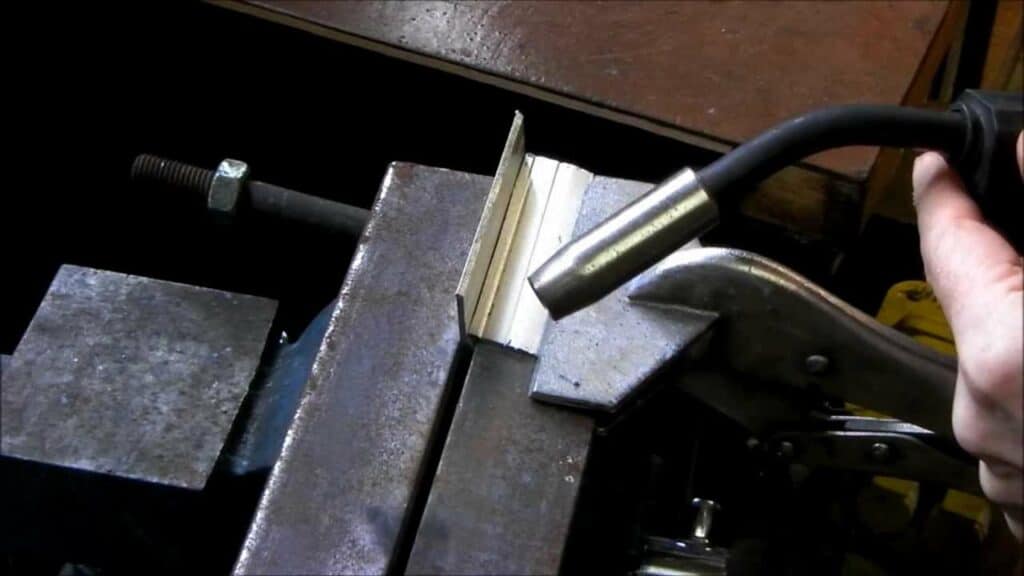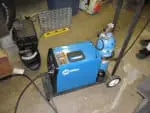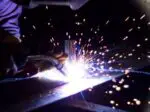Welding aluminum using MIG technique is a one-of-a-kind experience. However, welding aluminum is far less complicated than you would think.
Welding is the technique of joining metal together by applying heat at a high enough temperature to melt and fuse the metal. And because aluminum is thinner and more prone to burn a hole through than stainless steel, the operation must be done slowly and carefully.
You can weld aluminum using the MIG method, and while it can be difficult to MIG weld aluminum, it is still possible. The technique will necessitate greater heat than mild steel, and does require proper methods and equipment.
How can you MIG weld aluminum?
Aluminum is a relatively soft metal that has various applications, however, it needs to be blended with alloy to boost its strength.
And because the characteristics of aluminum differ substantially from those of steel, working with it can bring some issues, such as deformation and susceptibility to heat input.
Despite these challenges, MIG welding aluminum is not difficult provided the correct equipment and methods are used.
When MIG welding aluminum for your application, keep these crucial aspects in mind.
Here is a video that can guide you throughout the process-
Here are a few tips on how you can properly MIG weld aluminum
1.) Use the proper method
Your angle is one of the most significant factors in obtaining a successful aluminum weld. So should you push or pull?
When welding aluminum with a MIG, always employ the forehand (push) welding direction. This ensures that the shielding gas adequately covers the weld puddle.
Pushing produces a flatter, broader bead with less penetration, and dragging produces a narrower bead with deeper penetration.
If you pull (or drag) your aluminum weld, the impurities will be trapped inside the weld puddle, resulting in a poor-quality weld.
2.) Thickness of the metal that is to be welded
MIG welding aluminum may be difficult, and it isn’t as beautiful looking as a TIG weld, but it’s much faster, so it’s normally used for a lot of production projects.
It also depends on the thickness of your material. 2mm thick base metal is about as thin as MIG will allow, much thinner and you’ll have to TIG it.
3.) Thoroughly clean the metal
Before welding, aluminum should be completely cleaned, that includes removal of any lubricants.
MIG welding aluminum is a dirtier technique than TIG welding it, and a small coating of black soot (carbon black- a brown sticky powder) on the weld, as well as some spatter, is usual, but too much soot is a concern.
Cleaning your aluminum completely and keeping it in pristine condition is just as important for MIG as it is for TIG.
4.) Ensure proper gas flow
The movement, angle and the gas are important factors that will influence how black the weld is. In general, aluminum requires a larger gas flow than steel.
And because aluminum is a non-ferrous metal, it necessitates a shielding gas that is 100 percent argon.
If you’re receiving a lot of carbon powder (black soot), simply turn your gas up first, with your pistol at a pushing angle of 5° to 10°.
And if your gas flow is pretty high and you’re pressing but still getting soot, make sure the gas isn’t polluted or that there aren’t any areas in the torch where oxygen is getting in.
5.) Fill in the missing gaps
Once you complete an aluminum weld, you frequently end up with a crater or fisheye. Fisheye is a spherical dent which might create a few problems if not filled up.
Fill in the missing gaps by pulling your torch back into the puddle and letting it bubble before releasing the trigger when you arrive at the end of your weld.
How to MIG weld aluminum?
This may be a time-consuming procedure, so let’s get it out of the way first. Aluminum will be a thinner metal than the steel commonly utilised in MIG welding.
Because aluminum is a softer metal than steel and stainless, feeding it through a torch lead becomes considerably more difficult.
There are a few things you can do with your MIG torch to mitigate this.
1.) The first step is to exchange your liner with a Teflon one, since they are meant for aluminum, to which you will connect a neck spring. While you’re changing the liner, replace your guide tube with one made of aluminum.
Make sure you have U-groove rollers, since they will hold the aluminum better and help prevent birdnesting (wires tangled together). Finally, you may acquire aluminum-specific contact tips, which will aid in wire feeding.
2.) The second thing to remember is to maintain the torch as stable as possible during welding. The shorter the torch, the simpler this seems to be, as well as the lesser the travelling time for the aluminum.
But it becomes difficult if you have a torch that is three or more metres long. Large loose curves or loops can still work fine, but any compact circles would almost certainly coil your wire.
You will also want an additional gas bottle. In contrast to steel and stainless MIG welding, which employ an ArCO2 (argon + carbon dioxide) mix, aluminum requires pure argon gas. If you’re not going to be welding a lot of aluminum, a tiny bottle will suffice.
Things you will require to MIG weld aluminum
Aluminum may be effectively welded using MIG welding. It must be chosen if spray arc welding or pulse welding procedures will be employed when selecting a welder.
1.) Spray arc welding requires an inverter power source, whereas pulse welding may be done with constant current or constant voltage devices.
2.) Because of the amount of heat required, MIG welding is appropriate for thinner gauges of aluminum sheets. Aluminum material thicknesses that may be MIG welded are 14 gauge and higher.
3.) For MIG welding aluminum, 100 percent argon is the ideal shielding gas to use.
4.) To achieve a quality weld, the welder must select a welding wire or rod with an alloy that is as close to that of the work parts as feasible.
MIG welding aluminum has several advantages, including:
1.) Filling in crooked edges.
2.) Capable of welding in all positions.
3.) Produces high quality welds.
4.) Welding thick materials.
5.) The constantly supplied wire frees up both hands for welding, increasing welding speed, weld quality, and total control.
6.) Weld spatter is kept to a minimum.
Here we have some tips for you on how can you weld safely
Always be sure to properly prepare your equipment before you start with your work. Welding is a skill that necessitates experience and a high level of safety.
Before you begin, always check the following items off your list to ensure your success and safety:
1.) Check your cords: Before striking your arc (forming your heat source), ensure that all wires connected to your apparatus are in excellent working condition.
Any frayed cables or line cuts must be disposed of or replaced. Keep in mind that your liner, rollers, and contact tip should all be the same size as your wire, e.g. 1mm wire needs 1mm sized consumables. Because of the softness of aluminum, mismatched size will also cause problems.
Therefore, it is always suitable to use aluminum-specific consumables.
2.) Examine your tension: More stress may be applied to a steel or stainless wire than to an aluminum wire, and too much tension can flatten or distort the wire. Be cautious not to loosen it too much, as too little tension causes the drivers to spin rather than push.
Getting all of these things just right may be a bit of a balancing act, trial and error is the most effective approach to figure out what works best for you.
3.) Adjust the flow rate of your shielding gas: Turn on your shielding gas and set the flow rate. Since we’re welding aluminum, we’ll need a larger flow rate to give a higher rate of heat.
MIG settings are typically set to 20 to 25 cubic feet per hour. Setting the right higher at approximately the 25 mark with aluminum will set you up correctly.
4.) Choose electrode polarity: MIG welding will necessitate reversal polarity to complete the task. That is, you will want a positive DC electrode. This is simple, you can adjust it using the settings option on the side of the welding machine.
Conclusion
Welding aluminum will be a tremendous challenge in the early stages as you develop patience, confidence, new skills, and problem-solving abilities.
Even with very simple MIG welding machines, it is feasible to successfully MIG weld aluminum with the correct equipment and best practises.








